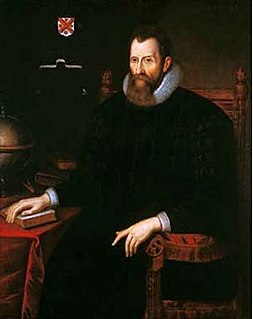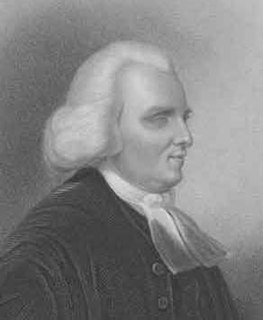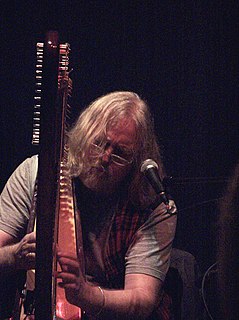
John Napier of Merchiston, nicknamed Marvellous Merchiston, was a Scottish landowner known as a mathematician, physicist, and astronomer. He was the 8th Laird of Merchiston. His Latinized name was Ioannes Neper.

"Auld Lang Syne" is a popular song, particularly in the English-speaking world. Traditionally, it is sung to bid farewell to the old year at the stroke of midnight on New Year's Eve. By extension, it is also often heard at funerals, graduations, and as a farewell or ending to other occasions; for instance many branches of the Scouting movement use it to close jamborees and other functions.
"Farewell to Nova Scotia" is a popular folk song from Nova Scotia, Canada. It was adapted from the Scottish lament "The Soldier's Adieu" written by Robert Tannahill. It was written sometime before or during World War I and popularized in 1964 when Catherine McKinnon used it as the theme song for the Halifax-based CBC TV program, Singalong Jubilee.

Thomas Blacklock was a Scottish poet who went blind in infancy.
"Frog Went a-Courtin'" is an English-language folk song. Its first known appearance is in Wedderburn's Complaynt of Scotland (1549) under the name "The Frog cam to the Myl dur", though this is in Scots rather than English. There is a reference in the London Company of Stationers' Register of 1580 to "A Moste Strange Weddinge of the Frogge and the Mouse." There are many texts of the ballad; however the oldest known musical version is in Thomas Ravenscroft's Melismata in 1611.
"A Red, Red Rose" is a 1794 song in Scots by Robert Burns based on traditional sources. The song is also referred to by the title "(Oh) My Love is Like a Red, Red Rose" and is often published as a poem. Many composers have set Burns' lyric to music, but it gained worldwide popularity set to the traditional tune "Low Down in the Broom"
Bothy ballads are songs sung by farm labourers in the northeast region of Scotland.

Robin Duncan Harry Williamson is a Scottish multi-instrumentalist, singer, songwriter, and storyteller who was a founding member of The Incredible String Band.

Sings the Songs of Robert Burns is the seventh studio album by Eddi Reader. It was released in the UK on 12 May 2003.

Poems, Chiefly in the Scottish Dialect, commonly known as the Kilmarnock Edition, is a collection of poetry by Robert Burns, first printed and issued by John Wilson of Kilmarnock on 31 July 1786. It was the first published edition of Burns' work. It cost 3 shillings and 612 copies were printed. The volume was dedicated to Gavin Hamilton. The Kilmarnock volume contained, besides satire, a number of poems like "Halloween", "The Twa Dogs" and "The Cotter's Saturday Night", which are vividly descriptive of the Scots peasant life with which he was most familiar; and a group like "Puir Mailie" and "To a Mouse", which, in the tenderness of their treatment of animals, revealed one of the most attractive sides of Burns' personality.

The Parish Church of St Cuthbert is a parish church of the Church of Scotland in central Edinburgh. Probably founded in the 7th century, the church once covered an extensive parish around the burgh of Edinburgh. The church's current building was designed by Hippolyte Blanc and completed in 1894.
"Oh, whistle and I'll come to you, my lad" is the title and refrain of a poem and song by Robert Burns, first written in 1787, and then expanded in 1793.
George Farquhar Graham (1789–1867) was a Scottish musicologist, who published a three-volume collected edition of Scottish songs, entitled Songs of Scotland, adapted to their appropriate melodies. Originally published by Wood and Co. of Edinburgh, the collection has been reprinted many times.

John Craig was a Reformer, and colleague of John Knox. Originally a Dominican, he became a Church of Scotland minister with significant extra responsibilities and played an influential part in the Scottish Reformation.

Classical music in Scotland is all art music in the Western European classical tradition, between its introduction in the eighteenth century until the present day. The development of a distinct tradition of art music in Scotland was limited by the impact of the Scottish Reformation on ecclesiastical music from the sixteenth century. Concerts, largely composed of "Scottish airs", developed in the seventeenth century and classical instruments were introduced to the country. Music in Edinburgh prospered through the patronage of figures including the merchant Sir John Clerk of Penicuik. The Italian style of classical music was probably first brought to Scotland by the cellist and composer Lorenzo Bocchi, who travelled to Scotland in the 1720s. The Musical Society of Edinburgh was incorporated in 1728. Several Italian musicians were active in the capital in this period and there are several known Scottish composers in the classical style, including Thomas Erskine, 6th Earl of Kellie, the first Scot known to have produced a symphony.

"Ca' the yowes to the knowes" is a Scottish folk song collected by Robert Burns from 1794. Although sometimes attributed to Burns himself, the seven-stanza original poem is thought to be the work of Ayrshire poet Isabel Pagan, a contemporary of Burns. The poem was partially revised by Burns, and he added an eighth stanza. Burns later re-wrote the poem on a solitary stroll in the country, and this second version consists of six stanzas. It is possible that Burns was not aware that Pagan was the original author, only noting that "this song is in the true Scottish taste, yet I do not know that either air or words were ever in print before."

Poems, Chiefly in the Scottish Dialect is commonly known as the Third or London Edition and sometimes the Stinking Edition. It is a collection of poetry and songs by Robert Burns, printed for A. Strahan; T. Cadell in the Strand; and W. Creech, Edinburgh. MDCCLXXXVII The date of publication for the London Edition was in November 1787, however Strahan and Cadell had previously advertised for sale the 'Second' or 'Edinburgh Edition' using the 500 or so copies that William Creech still had that were unsold. The successful selling of these made a truly new 'London Edition' a commercially viable enterprise.

David Williamson was a Scottish minister and Covenanter who served as moderator of the General Assembly of the Church of Scotland in 1702. He is notable for his long association with Edinburgh's West Kirk, his seven marriages, and his portrayal in the traditional song "Dainty Davie".
Jean Lorimer (1775–1831) was a friend of the poet Robert Burns, often referred to by him as the "Lassie wi' the lint-white locks" or "Chloris". Lorimer was born at Craigieburn House on a small estate near Moffat and from 1788 to 1791 was a neighbour of Burns when he was living at Ellisland Farm, her father's new farm being at Kemmishall or Kemys Hall, Kirkmahoe Parish, two miles to the south of Ellisland on the opposite bank of the Nith. Burns commented "The Lady on whom it was made, is one of the finest women in Scotland" in a letter to George Thomson, enclosing one of the two dozen or so songs that he wrote for her. They first met when she was a teenager through his Excise duties bringing him to their farm.

Poems, Chiefly in the Scottish Dialect was a 'pirated' edition of Robert Burns's work, being published in Ireland without permission from or payment to the author or publisher. It is a so-called 'Stinking Edition', carrying the error 'Stinking' for the Scots word 'Skinking' (watery) in the poem "To a Haggis" because the type setters copied from a 1787 'Stinking Edition' of Poems, Chiefly in the Scottish Dialect .













